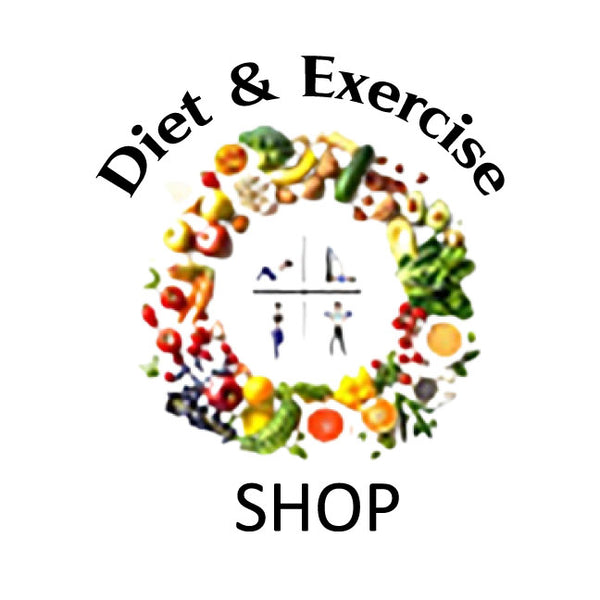
Best Dumbbells for Home Gym: Top Picks & Buying Guide
When you start looking for the best dumbbells for a home gym, you'll quickly find yourself at a crossroads with two main paths: adjustable dumbbells and fixed dumbbells. One offers incredible flexibility in a tiny package, while the other is the classic, tough-as-nails choice you see in every commercial gym. Picking the right one really just comes down to your space, your fitness goals, and what you’re willing to spend.
Your Quick Guide to the Best Home Gym Dumbbells
Choosing dumbbells can feel like a huge commitment, but it doesn't have to be overwhelming. A good set of weights is the cornerstone of any decent home gym setup. They’re arguably the most versatile piece of equipment you can buy for building strength, toning up, and just getting healthier.
This guide is here to cut through the noise. We'll break down the two main players—adjustable and fixed dumbbells—and lay out what makes each of them tick. The goal is to help you make a smart investment in yourself and create a workout space that you'll actually want to use.
Adjustable vs Fixed Dumbbells
The biggest fork in the road here is space versus convenience. Adjustable dumbbells are the ultimate space-savers, packing an entire rack of weights into a single, compact pair. This makes them a no-brainer for apartments or any room that has to pull double duty. You can switch from a light weight for bicep curls to a heavy one for squats in seconds.
Then you have fixed dumbbells. These are the traditional, single-weight dumbbells you’re used to grabbing at the gym. They are built like tanks, dead simple to use, and perfect when you want to fly through a workout without fiddling with dials or pins. If you've got the room for a rack, collecting a set of fixed weights offers unmatched durability. For a closer look at other must-have gear, take a look at our guide on home gym equipment essentials.
This image sums up the core differences perfectly, showing how they stack up in terms of weight range, cost, and the footprint they'll leave in your home.
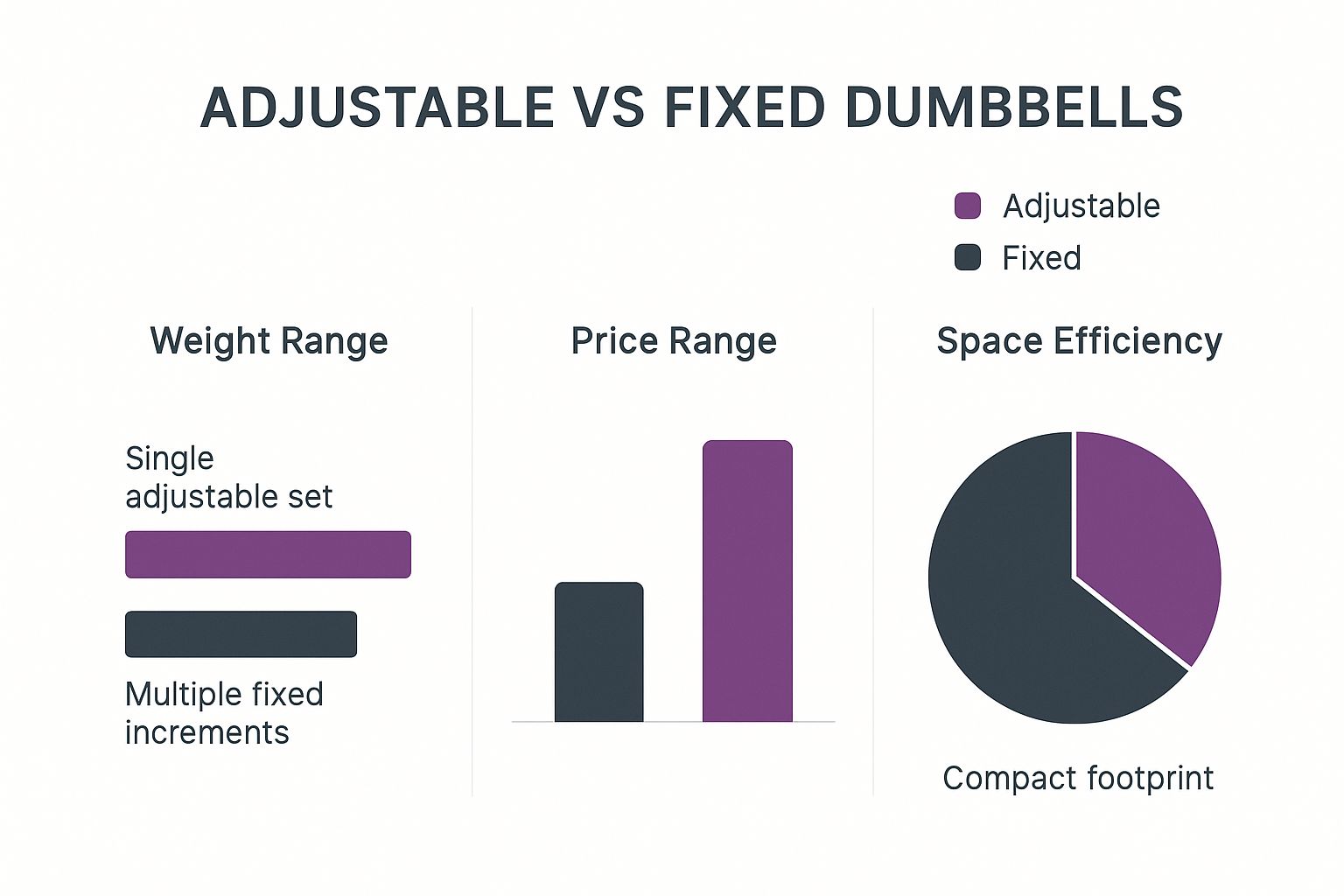
As you can see, the adjustable option is a clear winner on saving space and often gives you a wider range of weight for your money. On the flip side, fixed dumbbells will eat up more floor space and require a bigger investment over time to build a full set.
To make things even clearer, here’s a quick side-by-side look at the different dumbbell types you’ll encounter.
Dumbbell Type Quick Comparison
This table breaks down the main options to help you see at a glance which style might be the best fit for your home gym.
| Dumbbell Type | Best For | Space Requirement | Cost | Key Feature |
|---|---|---|---|---|
| Fixed Hex Dumbbell | Durability, fast-paced workouts, and beginners. | High (requires a rack for a full set) | Moderate to high for a set | The hexagonal shape prevents rolling. |
| Adjustable Dumbbell | Small spaces, progressive overload, and all-in-one convenience. | Very Low | High upfront, but cost-effective long-term. | Replaces multiple pairs of dumbbells. |
| Loadable Dumbbell | Heavy lifters, budget-conscious buyers, and customization. | Low to Moderate | Low upfront | Allows use of standard weight plates. |
Ultimately, the best choice is the one that fits seamlessly into your life and makes you want to work out.
The right dumbbell choice is one that removes friction from your routine. If you're short on space, an adjustable set is your best bet. If you value speed and simplicity, a few pairs of fixed weights will serve you well.
Remember to pair your hard work with a solid nutrition plan to see real results. If you’re building muscle, focus on getting enough protein to help your body repair and grow. If weight loss is the goal, combine your strength training with a small calorie deficit and plenty of nutrient-rich foods. This holistic approach is what turns effort into achievement.
Why Dumbbells Are a Home Gym Essential
The way we think about fitness has completely changed. Fewer people are willing to put up with crowded gyms and class schedules that don't fit their lives. The home gym is no longer a luxury; it's the new standard for anyone serious about building strength on their own terms. And right at the heart of this shift is the single most effective tool you can own: a good set of dumbbells.
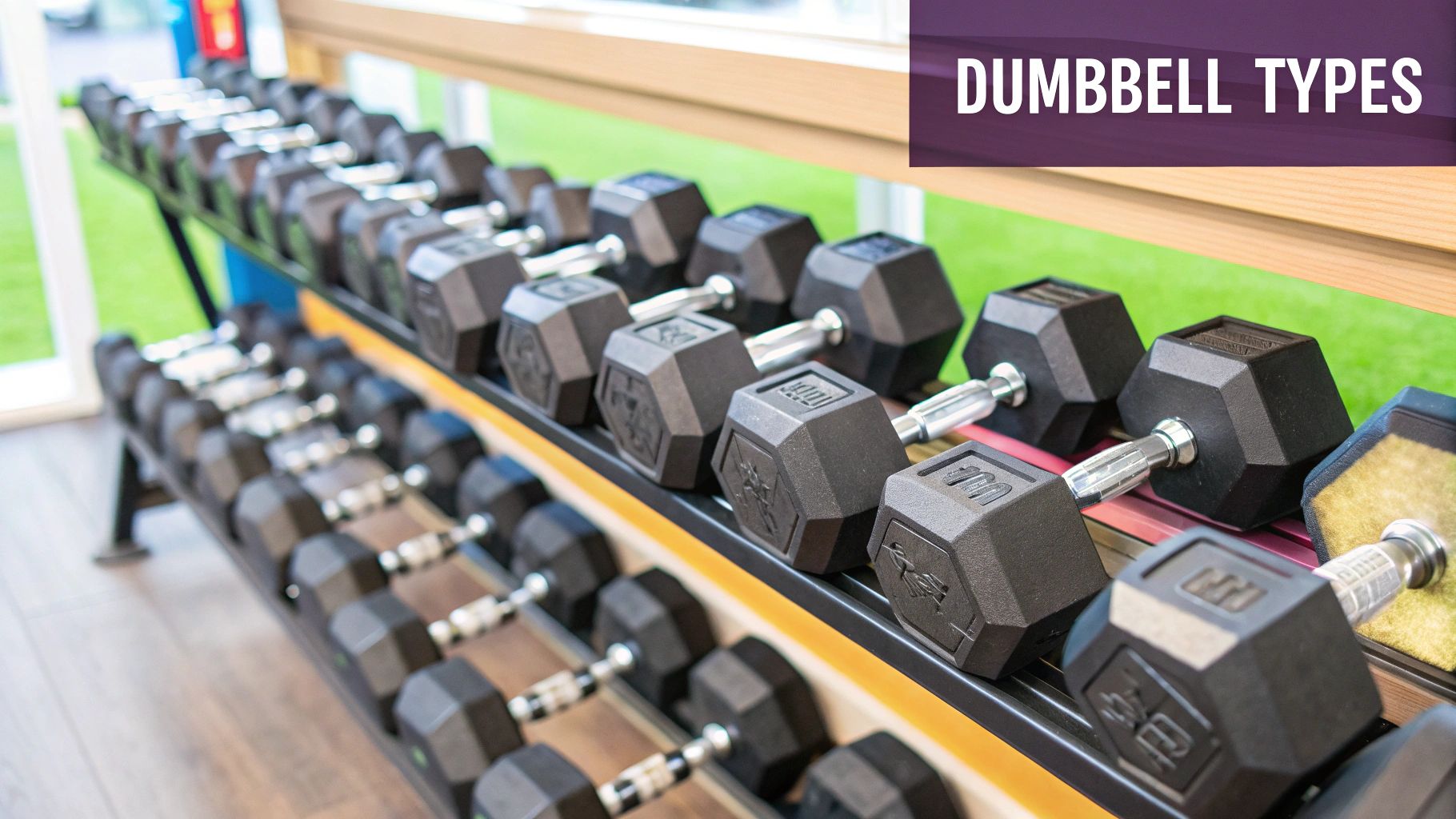
Unlike those big, clunky machines that only do one thing, dumbbells are the ultimate multitaskers. They open the door to hundreds of exercises targeting every major muscle group in your body. From bicep curls and shoulder presses to lunges and goblet squats, they are the key to a true full-body workout.
This incredible adaptability makes them perfect for literally everyone. It doesn't matter if you're just starting out or you're a seasoned lifter—the right set of dumbbells lets you fine-tune your routine to match your exact goals.
Fueling a Global Fitness Trend
This move toward home workouts isn't just a fleeting trend; it’s a massive market shift. The global dumbbells market was valued at around USD 3.94 billion and is on track to hit USD 6.52 billion by 2032. What’s driving this? A worldwide boom in health awareness and a real need for fitness that fits into our busy schedules. If you're curious about the numbers, you can explore the research on the growing dumbbell market.
This explosion in popularity points to one simple truth: people are investing in equipment that delivers the most bang for their buck with the smallest footprint. This is especially true for adjustable dumbbells, which have become a go-to for their brilliant space-saving design.
The Perfect Pairing of Diet and Exercise
Having the right equipment is a huge first step, but real, lasting results come from pairing smart workouts with smart nutrition. Dumbbells are fantastic for building lean muscle, and more muscle means a faster metabolism. But to build that muscle, your body needs fuel—and that means protein.
Think of it like building a house:
- Your Workout: Dumbbell exercises are like the construction crew creating micro-tears in your muscles. This is the signal for your body to start rebuilding and get stronger.
- Your Diet: Protein delivers the bricks and mortar (amino acids) your body needs to repair those muscles, making them bigger and more powerful.
For example, after a tough upper-body session, a meal with lean chicken or a quick protein shake is exactly what your body needs to kickstart recovery. This powerful link between what you lift and what you eat is what turns your hard work into real, visible results.
Investing in a quality set of dumbbells is an investment in your long-term health. They provide the foundation for consistent strength training, which, when paired with a balanced diet, is one of the most effective ways to achieve and maintain your fitness goals.
At the end of the day, the best dumbbells are the ones that tear down the barriers to working out. They’re always there, ready when you are, killing off excuses like "I don't have time to get to the gym." By making strength training this accessible, they empower you to build healthy habits that stick for life.
Adjustable Dumbbells: The Space-Saving Powerhouse
If you're trying to build a serious home gym but are short on space, adjustable dumbbells are nothing short of a miracle. Imagine taking an entire rack of 15 or more pairs of dumbbells and condensing it all into a single, compact set you can slide into a corner. That's the brilliance behind their design. The DietExerciseShop Adjustable Dumbbells are a perfect example of this all-in-one convenience.
This makes them a perfect fit for anyone in an apartment or a house where the workout area has to double as a living room or office. You get all the benefits of a full weight set without sacrificing your living space.
It’s this efficiency that makes them one of the smartest investments you can make for your fitness. Instead of constantly buying heavier dumbbells as you get stronger, you just add more weight to the set you already have. This is progressive overload in its purest form, and it's the key to building muscle over the long haul.
Plus, the versatility is fantastic for keeping your workouts dynamic. You can go from heavy lunges right into a set of light lateral raises in just a few seconds. This keeps your heart rate up and your rest times down—perfect for circuit training.
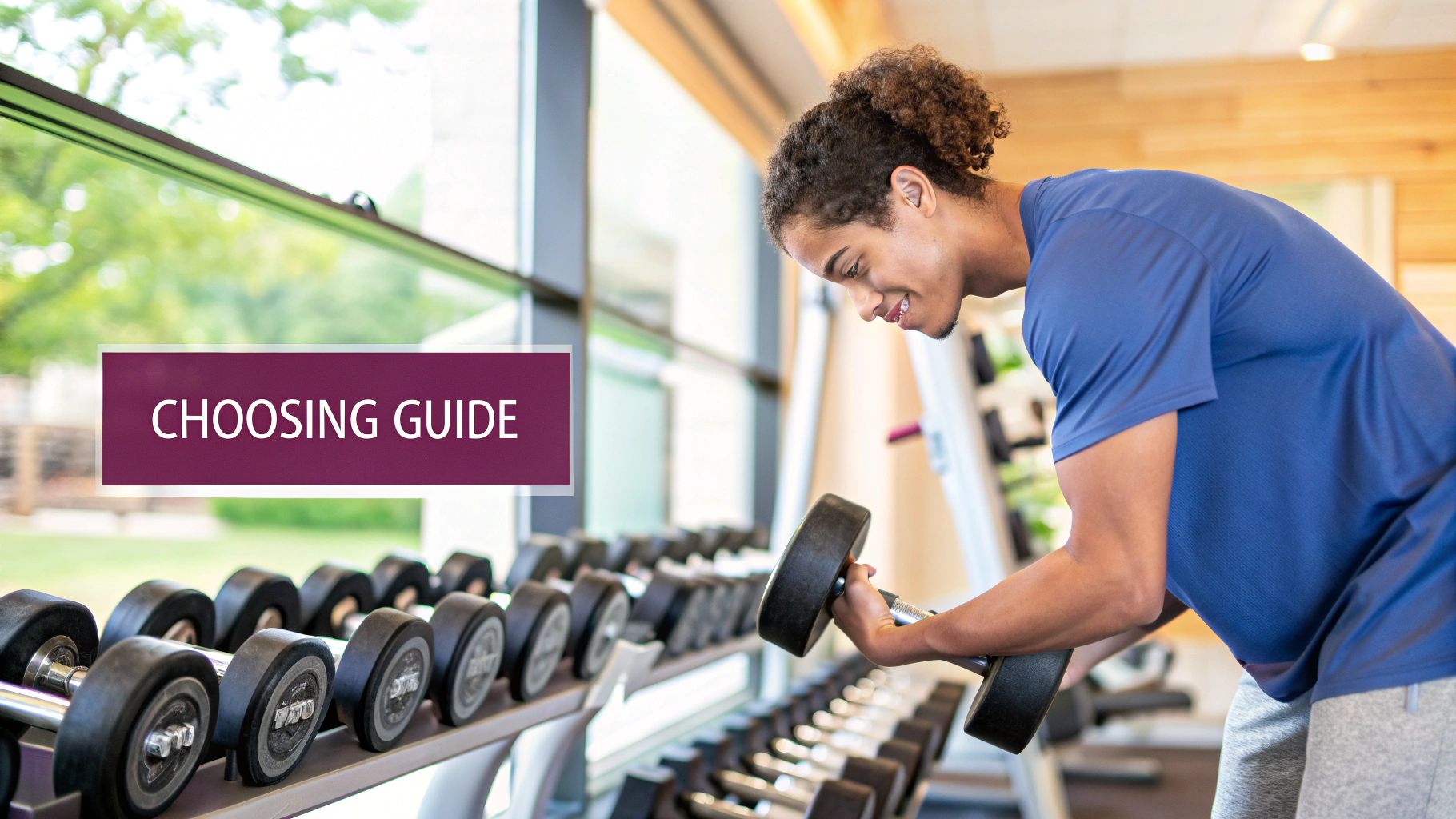
So, How Do They Actually Work?
Most adjustable dumbbells rely on one of a few clever mechanisms. Getting familiar with them will help you pick the right set for your training style, as each has a slightly different feel and speed.
You'll generally come across three common systems:
- The Dial System: This is probably the one you’ve seen most often. You just turn a dial at the end of the dumbbell to select the weight. The internal mechanism then grabs the right number of plates, leaving the rest behind in the cradle. Simple and effective.
- The Selector Pin: Think of the weight stacks at a commercial gym. This system uses a pin that you slide into a slot for the weight you want. It’s a very secure and straightforward method that feels familiar to many lifters.
- The Twist-Lock Handle: With this style, you set the handle in its cradle and just give it a twist. You'll hear it click as it locks onto the weight plates. This is often the fastest system for changing weights.
The real magic of adjustable dumbbells is how they combine an entire gym's worth of weights into one elegant package. You're not just saving a ton of space; you're also making a much more cost-effective choice than buying dozens of individual dumbbell pairs over time.
Matching the Weight Range to Your Goals
Picking the right weight range is absolutely crucial. Go too light, and you'll outgrow your investment in a few months. Go too heavy, and you're paying for potential you might not tap into for years.
For beginners just getting started or anyone focused on general fitness, a set that maxes out around 25-50 lbs per dumbbell is a fantastic starting point. This gives you plenty of room to grow while covering all the essential upper and lower body exercises. To see how these fit into a complete home gym, check out our guide on the best home workout equipment for small spaces.
If you're an intermediate or advanced lifter with your sights set on building serious muscle, you'll want to look for sets that go up to 70-90 lbs. This heavier range is a must for challenging yourself on big compound movements like dumbbell bench presses, heavy rows, and goblet squats.
Don't Forget to Fuel Your Progress
Lifting weights is only half the battle. To see real results, you have to pair your training with solid nutrition. Think of your workouts as the signal that tells your body to build muscle, and your food as the building blocks it needs to get the job done.
A good rule of thumb is to aim for roughly 1 gram of protein per pound of body weight each day. This ensures your muscles have the fuel they need to repair and grow back stronger. When you combine smart training with smart eating, you’ll reach your goals much faster.
Fixed Dumbbells: The Classic Choice for Durability
While adjustable dumbbells are clever pieces of engineering, there's a reason the classic, no-fuss fixed dumbbell has stood the test of time. These are the workhorses you see lining the racks of every serious gym, and for good reason: they're incredibly durable, dead simple, and always ready for your next set. There are no dials to turn or pins to fiddle with—you just grab them and go.
That simplicity is their biggest advantage. If you're into fast-paced workouts like supersets or drop sets, fixed dumbbells are king. You can drop one pair and immediately grab the next without breaking your rhythm, which keeps your heart rate up and the intensity exactly where you want it. It removes that tiny moment of friction that can sometimes make you hesitate to start a workout.
Their solid construction also means they can take a beating for years. They're typically made from a single piece of cast iron or steel, often coated in rubber, with basically no moving parts to break. This makes them a true long-term investment in your fitness—a reliable tool that will be a fixture in your home gym for decades. The Rubber Hex Dumbbell Set is the perfect example of this durable, grab-and-go style.
Choosing the Right Material for Your Space
Fixed dumbbells come in a few different materials, and each has its own vibe and benefits. The hands-down favorite for most home gyms is the rubber hex dumbbell. Their hexagonal shape is a game-changer because it stops them from rolling away between sets—a huge plus for safety and convenience. The rubber coating also protects your floors and dampens noise, which is a must when you're working out at home.
This is exactly what a high-quality rubber hex dumbbell set looks like—a perfect foundation for any home gym.
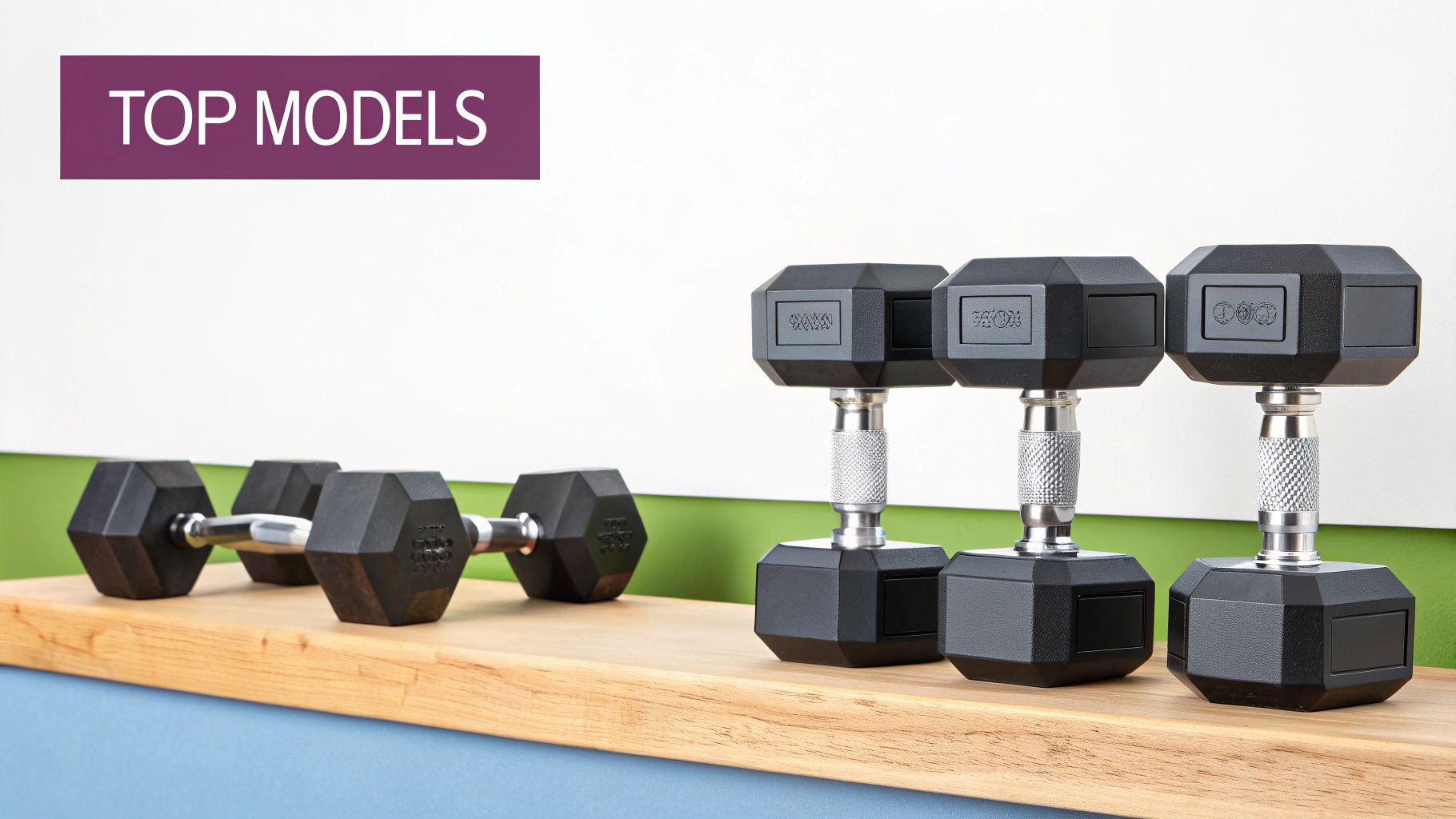
You can see the classic design in that image—clear weight markings and that knurled, ergonomic handle that ensures you get a solid grip. A set like this is a fantastic starting point for any lifter.
Of course, there's always the classic cast iron dumbbell. These have that timeless, old-school gym feel and are often a bit more compact than their rubber-coated cousins at the same weight. Just be aware they aren't very forgiving on floors, so you'll definitely want to use them on a protective mat.
Finally, you have neoprene-coated dumbbells. You usually see these in lighter weights, from about 1 to 20 pounds. The soft, grippy coating feels comfortable in your hands and is less intimidating for beginners. They're perfect for high-rep toning workouts.
How to Build Your Starter Set Strategically
When you first decide to get fixed dumbbells, it’s tempting to go all-in on a massive set. A smarter, more budget-friendly way is to start with a few key pairs and build your collection over time. For anyone new to lifting, three pairs is a great place to start:
- A light pair (5-10 lbs): These are perfect for warming up and for isolation exercises like lateral raises or tricep kickbacks.
- A medium pair (15-25 lbs): This will be your workhorse for foundational movements like bicep curls, overhead presses, and lunges.
- A heavy pair (30-40 lbs): You'll use these for bigger compound exercises like goblet squats, chest presses, and dumbbell rows.
The real beauty of a fixed dumbbell collection is that it grows with you. As you get stronger, you just add the next weight up. Each new pair is a tangible trophy marking your progress, which is an incredible motivator.
Remember, your results come from pairing smart training with smart nutrition. To build muscle, you need to feed your body enough protein to repair and rebuild after each session. When you combine a challenging dumbbell routine with a nutrient-dense diet, you give your body the fuel it needs to get stronger, turning all that hard work into visible, lasting change.
How to Choose the Right Dumbbells for You
Picking the right dumbbells for your home gym goes way beyond just grabbing the heaviest weight you think you can lift. It’s the little things that make a massive difference in your daily workouts and long-term progress—the feel of the handle, the material, and how they actually fit with your goals. Getting these details right means you're investing in a tool you'll genuinely want to pick up day after day.
The right pair feels like an extension of your body, helping you keep your form tight and preventing injuries. That’s why the handle and the material are so critical.
Nail the Grip Handle Ergonomics
The handle is your one and only connection to the weight, so its design can literally make or break an exercise. Two things you need to pay close attention to here are grip diameter and knurling. A handle that’s too thick is a nightmare to hold onto, especially for smaller hands. A handle that’s too thin can dig painfully into your palms during heavy presses.
Then there's knurling—that cross-hatched, textured pattern on the handle. It’s there to give you a solid grip, even when your hands start sweating. Knurling comes in a few different flavors:
- Passive Knurling: A finer texture that helps with grip but isn't abrasive. You'll often see this on vinyl or neoprene dumbbells.
- Aggressive Knurling: A deep, sharp pattern that delivers a rock-solid grip for serious lifting, but it can be pretty rough on your hands.
- Medium Knurling: This is the sweet spot for most people. It offers an excellent grip without tearing up your palms, making it perfect for all kinds of exercises.
A comfortable, secure grip is completely non-negotiable. If you’re constantly fighting just to hold on, your focus shifts from working the muscle to simply not dropping the weight. This is where good knurling truly proves its worth.
Choose the Right Material for Your Home
Dumbbells are made from a few different materials, and each has its own pros and cons when it comes to durability and protecting your floors. The big three are cast iron, rubber, and urethane.
Cast iron is the old-school, no-frills classic. They’re incredibly durable and usually more compact than coated dumbbells of the same weight. The downside? They can chip if you drop them and they will absolutely destroy a hardwood floor, so a good mat is a must.
Rubber-coated dumbbells, especially the popular hex-shaped ones, are a fantastic choice for most home gyms. The rubber casing saves your floors from damage, cuts down on noise, and makes the dumbbells themselves far more resistant to chipping and rust. Plus, that hex shape means they won't roll away. Our Rubber Hex Dumbbell Set is the perfect example of this durable, home-friendly design.
Urethane-coated dumbbells are the top-of-the-line option. Urethane is even tougher than rubber, doesn't have that signature rubbery smell, and stands up incredibly well to scratches and sunlight. They’re a bigger investment upfront, but they are built to last a lifetime.
Align Your Dumbbells with Your Fitness Goals
Ultimately, the best dumbbells for you are the ones that match what you’re trying to achieve. Your goals should guide everything, from the type you buy to the weight range you need.
For building muscle (hypertrophy), you need weights heavy enough to challenge you in the 8-12 rep range. This usually means you’ll need a wide variety of weights to keep progressing, which makes a versatile set like the Diet & Exercise Shop Adjustable Dumbbells a really smart choice.
If your goal is more about muscular endurance or toning, you'll be working with lighter weights for higher reps (think 15-20+). In that case, a few pairs of fixed neoprene or rubber hex dumbbells in a light-to-moderate range will be perfect.
The global demand for home gym gear really shows how varied these needs are. Interestingly, a huge part of the dumbbell market is now driven by the Asia Pacific region, especially China, thanks to a growing middle class and new health initiatives. Discover more insights about the global dumbbell market.
Putting Your Dumbbells to Work
So you've picked out the perfect set of dumbbells. That's a huge first step, but they don't do much just sitting in the corner. The real value comes from a solid routine that turns that raw potential into real results. A smart workout plan, paired with good nutrition, is what will get you from point A to point B.
Building a routine isn't as intimidating as it sounds. The goal is simple: hit all your major muscle groups throughout the week. This approach builds balanced, functional strength and keeps your body guessing, which is exactly what you want for continuous progress.
A Simple, Effective Dumbbell Plan
One of the most effective ways to structure your week is with a "split" routine. You'll dedicate different days to different muscle groups, giving each one ample time to rest and rebuild. That recovery period is crucial—it's when your muscles actually get stronger.
Here’s a classic split to get you started:
- Day 1: Push Day: Think chest, shoulders, and triceps. Dumbbell bench presses, overhead presses, and tricep kickbacks are your go-to moves here.
- Day 2: Pull Day: Time to hit your back and biceps. This means dumbbell rows, reverse flyes, and plenty of bicep curls.
- Day 3: Leg Day: Don't skip it! Work your quads, hamstrings, and glutes with exercises like goblet squats, lunges, and Romanian deadlifts.
Getting the form right is non-negotiable. It’s the difference between building muscle and getting injured. For clear, step-by-step video tutorials on these foundational movements, check out the workout tutorials on the dietexercise YouTube channel. We break everything down so you can lift with confidence.
The real secret to getting fit? Consistency. A plan you can actually stick to is infinitely better than a "perfect" one you abandon after a week. Find exercises you don't hate and healthy foods you genuinely enjoy. That's the winning formula.
Don't Forget to Fuel the Machine
Your workouts are only half the story; what you eat is the other, equally important half. Think of your training as flicking the switch for muscle growth, and your food as the electricity that powers it. Without the right nutrients, your body simply can't repair and build muscle, no matter how hard you work.
An easy rule to follow is to get a good dose of protein after you train. Protein delivers the amino acids your body needs to patch up the muscle fibers you just worked, making them bigger and stronger. A simple meal with some lean chicken or even a quick protein shake within an hour or two of your workout can make all the difference.
Making Fitness a Habit, Not a Chore
The good news is that fitness is getting more creative and fun. A huge trend driving the home gym boom is "exergaming," where exercise meets interactive video games. It’s completely changing how people view working out, turning it from a task into an engaging activity.
This shift is a big reason why dumbbell sales have skyrocketed. The global market is expected to grow by a massive USD 222.4 million between 2024 and 2029. People are looking for fitness that fits their life—blending strength, cardio, and a bit of fun. You can read the full research about these market trends if you're curious.
The takeaway is simple: mix your dumbbell workouts with other activities you love. When fitness feels like a part of your lifestyle instead of an obligation, you're much more likely to stick with it for the long haul.
Got Questions About Home Gym Dumbbells? Let's Talk.
Deciding on the right dumbbells for your home gym usually brings up a handful of questions. It's totally normal. Getting straight answers is the key to picking gear you’ll use safely and love for years to come. Let's dig into a couple of the most common ones I hear.

The biggest hurdle for most people? Figuring out what weight to start with. It can feel like a huge, intimidating decision, but the core idea is simple: you want a weight that challenges you without wrecking your form.
What Weight Should I Start With?
If you're just starting, your goal is to find a weight that lets you complete 10-15 reps while maintaining good technique. The last couple of reps should feel like work, but not so tough that you start flailing around.
- For most women, a pair of 5-10 lb dumbbells is a fantastic starting point.
- For most men, starting somewhere in the 10-20 lb range usually works well for basic exercises.
This is exactly why adjustable dumbbells are such a game-changer for beginners. You can start light and slowly dial up the weight as you get stronger, all without having to buy a whole new set of dumbbells. If you need some ideas for beginner-friendly moves, our YouTube channel is a great resource.
Are Adjustable Dumbbells As Tough As Fixed Ones?
Honestly? No. It's hard to beat the sheer durability of a solid chunk of cast iron or rubber. Fixed dumbbells are pretty much bomb-proof because there's nothing to break.
That said, a good-quality adjustable dumbbell set is more than tough enough for a home gym. As long as you aren't dropping them from a great height after every set, a reputable brand will hold up beautifully for years. The moving parts are the trade-off for convenience, but for most people, it's a trade worth making.
A little care goes a long way. Just wipe your dumbbells down with a damp cloth to get rid of sweat and prevent rust. If you have adjustables, give the locking mechanism a quick check now and then. Storing them somewhere dry protects both the weights and your floor.
It’s just a few seconds of upkeep to protect your investment.
At Diet and Exercise, we know the right equipment is a huge motivator. To find gear that can keep up with your progress, check out our versatile collection at https://dietexerciseshop.com.
